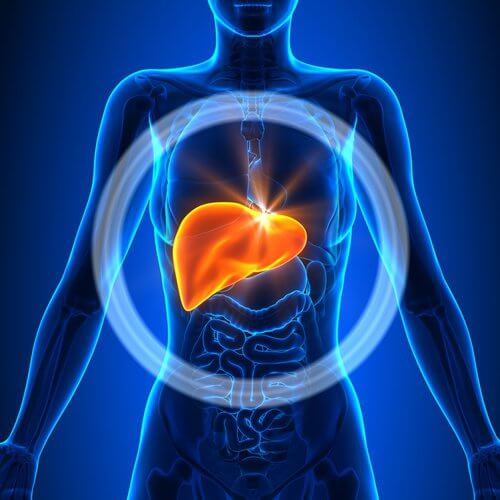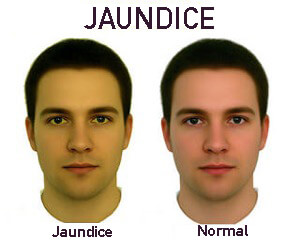9 Symptoms that Indicate Liver Inflammation


Written and verified by the doctor Nelton Abdon Ramos Rojas
This condition has become quite common nowadays. In order to know how to detect it, we recommend reading this article.
The liver, a key organ

The liver is the organ in charge of the body’s detoxifying functions. It acts in the following ways:
- Detoxifies
- Cleans the blood
- Cures various infections
- Stores vitamins and energy
- Secretes bile, a necessary substance for digestive activities
Hepatomegaly
Hepatomegaly is the pathological enlargement of the liver. It’s not a disease per se but a sign of an underlying problem. Thus, it’s a manifestation of an underlying disease.
Hepatomegaly or liver inflammation doesn’t only imply an enlargement or broadening of the liver. It also means it’s surpassed its normal limits which can lead to many complications.
At the same time, the surrounding organs stop working as they should. Thus, the entire body begins to malfunction when the liver gets sick.
How to know if you have liver inflammation
Although it isn’t easy to know if you have an inflamed liver, certain warning signs can tell you that it’s time to go see a doctor.
1. Pain
Although the pain can be very subtle at first, it’ll worsen as the days pass. What characterizes this pain is its location: it’s always in the upper-right area of the abdomen.
At the same time, the abdomen might be inflamed or swollen. This swelling will worsen gradually in the following days.
2. A fever
A fever is a sign of alteration in the body’s health due to infections, viruses, or bacteria. Nevertheless, it could also be related to the liver.
If you have an ongoing fever, something isn’t right in your body. If you have an inflamed liver, it’s normal to have fevers regularly.
We recommend Home Remedies for When You Have a Fever
3. Jaundice

Jaundice is linked to liver health. If your liver is sick, you’ll start to notice your skin and eyes turning yellow.
This symptom is a consequence of high bilirubin blood levels that always leads medical professionals to think of some kind of liver disorder.
4. Nausea
Remember that the liver is responsible for eliminating toxins and substances that the body can’t process. This leads to another characteristic symptom: nausea.
If the liver fails, some foods will be hard to digest, causing nausea and general malaise. For example, foods rich in fats, salt, and flour and even those that are heavily seasoned.
5. The stool
You can always determine the status of your body’s health by examining stool and urine. Though it might not be a pleasant view, it’s a good idea to stop and observe for a few seconds.
When this organ fails to do its job, stools can become lighter in color, even white. At the same time, urine can become very dark and have an acidic consistency.
6. Bad taste in the mouth
A bad taste in the mouth is also a common symptom of liver inflammation. However, other pathologies can cause this symptom as well.
You can experience a bad taste in your mouth because toxins and substances, that should’ve been eliminated, will start to build up. As a result, they produce foul odors that are redirected towards your mouth, causing a bad taste.

7. Digestive problems
As we’ve already mentioned, the liver participates in the digestion of multiple foods, especially fats. In this sense, the difficult digestion of certain foods may indicate that something is not working properly in the liver. People may report a feeling of heaviness, gas, and abdominal discomfort.
8. Excessive fatigue
Another common symptom of liver disease is fatigue or excessive tiredness for no apparent reason. According to the Catalan Association of Liver Patients, researchers do not know the exact cause of this manifestation. However, it’s believed that it appears due to the alteration of hormones and brain chemistry.
9. Swelling in the abdomen and lower limbs
Liver diseases can cause fluid retention, which is the accumulation of liquids in the extremities. Abdominal edema is very common in the case of liver diseases, so it’s possible to see it if you have an inflamed liver. This symptom is also known as ascites.
Meanwhile, the edema can progress and affect the lower limbs, and even the entire body in the most severe cases. This last condition is known as anasarca and is a reason to visit the doctor immediately.
Ascites can compress the abdomen and stomach, so people may have decreased appetite and gastroesophageal reflux. It’s also possible to notice an increase in weight, which will be due to the accumulation of fluid from the edema.
What may cause liver inflammation?
As the liver is an organ that’s linked to all of the body’s processes, many factors can affect it, such as:
- Excess weight
- Obesity
- Alcoholism
- Bacterial infections
- Medication intoxication
- Infection with hepatitis viruses
Is it possible to prevent liver inflammation?
As you can see, there are multiple causes that can generate liver inflammation. In this sense, there is no measure that is 100% effective in preventing all these pathologies. However, a healthy lifestyle helps maintain good health in general and prevent multiple conditions, including liver conditions.
In this way, some of the tips you can follow to avoid having an inflamed liver are the following:
- Maintain a healthy and balanced diet
- Moderate your alcohol intake
- Follow directions when taking medication
- Keep a healthy weight
- Avoid herbal teas, especially in the case of children
- Give up smoking
- Limit contact with harmful chemicals
To keep in mind
If you notice discomfort and have concerns, see your doctor for an evaluation. Under no circumstances should you resort to self-medication or natural remedies, as they could be counterproductive.
All cited sources were thoroughly reviewed by our team to ensure their quality, reliability, currency, and validity. The bibliography of this article was considered reliable and of academic or scientific accuracy.
- Aguilera-Méndez, A. (2018). Esteatosis hepática no alcohólica: una enfermedad silente. Revista Médica del Instituto Mexicano del Seguro Social, 56(6), 544-549. https://www.redalyc.org/journal/4577/457758893007/html/
- Asociación Catalana de Pacientes Hepáticos. (3 de marzo de 2019). ¿Cuáles pueden ser los síntomas de la enfermedad del hígado? https://asscat-hepatitis.org/cuales-pueden-ser-los-sintomas-de-la-enfermedad-del-higado/
- Azer, S. A., & Sankararaman, S. (2023). Steatorrhea. StatPearls. https://www.ncbi.nlm.nih.gov/books/NBK541055/
- Caballería, L., & Parés, A. (2003). Un enfermo ictérico. Medicina Integral, 41(2), 70–78. https://www.elsevier.es/es-revista-medicina-integral-63-articulo-un-enfermo-icterico-13045398
- Castaing, D., & Veilhan, L.-A. (2006). Anatomía del hígado y de las vías biliares. EMC – Técnicas Quirúrgicas – Aparato Digestivo, 22(4), 1–12. https://www.sciencedirect.com/science/article/abs/pii/S1282912906478466
- Chiejina, M., Kudaravalli, P., & Samant, H. (2023). Ascites. StatPearls. https://www.ncbi.nlm.nih.gov/books/NBK470482/
- Diplomado en Ultrasonografía Médica. (14 de diciembre 2015). Pérdida de peso durante la cirrosis en relación con la etiología de la enfermedad hepática. Médica Capacitación. https://diplomadomedico.com/perdida-de-peso-durante-la-cirrosis-en-relacion-con-la-etiologia-de-la-enfermedad-hepatica/
- Galán, I.,
- Guerra-Ruiz, A. R., Crespo, J., López Martínez, R. M., Iruzubieta, P., Casals Mercadal, G., Lalana Garcés, M., Lavin Gomez, B. A., & Morales Ruiz, M. (2021). Bilirrubina: Medición y utilidad clínica en la enfermedad hepática. Advances in Laboratory Medicine, 2(3), 362–372. https://www.ncbi.nlm.nih.gov/pmc/articles/PMC10197379/
- Joseph, A., & Samant, H. (2023). Jaundice. StatPearls. https://www.ncbi.nlm.nih.gov/books/NBK544252/
- Kalakonda, A., Jenkins, B. A., & John, S. (2022). Physiology, Bilirubin. StatPearls. https://www.ncbi.nlm.nih.gov/books/NBK470290/
- Mehta, P., & Reddivari, A. K. R. (2022). Hepatitis. StatPearls. https://www.ncbi.nlm.nih.gov/books/NBK554549/
- Sherman, R. (1990). Abdominal pain. Clinical Methods: The History, Physical, and Laboratory Examinations. Stat Pearls. https://www.ncbi.nlm.nih.gov/books/NBK412/#_ncbi_dlg_citbx_NBK412
- Sibulesky, L. (2013). Anatomía normal del hígado. Clinical Liver Disease, 2(4), 61-63. https://www.ncbi.nlm.nih.gov/pmc/articles/PMC6519334/
- Velásquez Gimón, M. E., & González Blanco, O. (2006). Diagnóstico y tratamiento de la halitosis. Acta odontologica venezolana, 44(3), 383–398. https://ve.scielo.org/scielo.php?script=sci_arttext&pid=S0001-63652006000300017
- Vildózola Gonzales, H. (2020). Etiología y mecanismos de desnutrición en el paciente cirrótico. Anales de la Facultad de Medicina, 81(2), 234–241. http://www.scielo.org.pe/scielo.php?script=sci_arttext&pid=S1025-55832020000200234
This text is provided for informational purposes only and does not replace consultation with a professional. If in doubt, consult your specialist.








